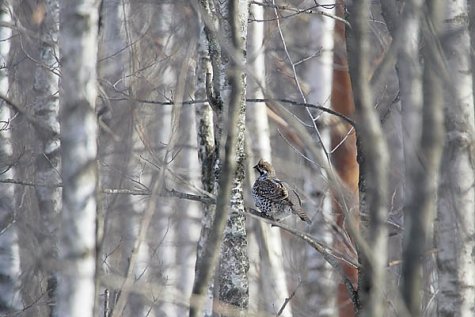Hazel grouse very sedentary in winter
Photo: Arne Ader
Translation: Liis
Hazel grouse
Hazel grouse Laanepüü Tetrastes bonasia
The hazel grouse is a native bird in Estonia, a gallinaceous bird with a rather small head and a stocky body. Males and females are quite similar in size, weighing about three to four hundred grams. In flight a distinctive whirring is heard and as all gallinaceous forest birds they take off from the ground noisily.
The back plumage of hazel grouses is grey with darker brown and grey flecks. The underparts are white, patterned with black and maroon spots. Wings and sides are rust brown, also mottled, and the tail has a black cross bar at the tip. The male has a large black patch framed in white on the throat, a bright red streak above the eyes and a crest at the neck. The female’s throat is off-white, there is only a hint of the neck crest and the whole of the plumage is somewhat paler. Both sexes have hair-like fringes on the toes in winter.
The pairs formed during the autumn display period in September-October often stay together during winter but may also separate. In winter they feed mostly on buds and catkins of deciduous trees, mostly alder and birch; thus it is in alder or birch forests or mixed forests that we can meet hazel grouse. An estimate of the numbers in winter would be sixty to a hundred thousand birds in winter.
An action program for the conservation of hazel grouse is being prepared. Among other things in the program the grouses' choice of habitats will be analysed. We certainly want the analysis to comprise as many good data as possible and the e-Biodiversity database is of course a valuable source from where we use bird observations. So, please, do enter your bird observations in the Estonian e-Biodiversity database:
For the habitat analyses (particularly for such a sedentary forest bird as the hazel grouse) it is however extremely important that the observations are accurate. From the e-Biodiversity data for instance we only use GPS observations with an accuracy of 100 m; those that are less accurate or where the accuracy is not specified we cannot use. We would be very grateful if watchers whose hazel grouse observations have been entered without note of the accuracy could add it in retrospect.
Who does not want to use the e-Biodiversity is welcome to send their hazel grouse observations (number of birds, activity, time of observation, coordinates, observers) by mail:
Best wishes,
Ülo Väli
Professor
Department of Zoology
Institute of Agricultural and Environmental Sciences Estonian University of Life Sciences
skype: ulovali









